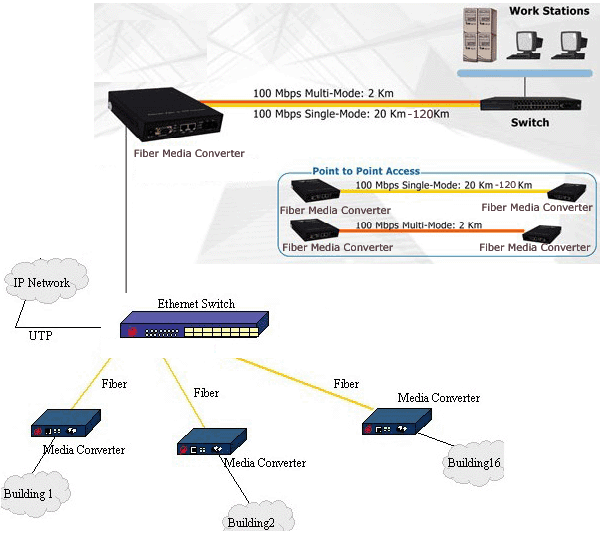-

- Sopto Home
-

- Special Topic
-

- Converter Knowledge
-

- 100Gb Ethernet Drivers and Technology
Converter Knowledge
- Form Factors and Application of Ethernet Media Converter
- Ethernet over 4 E1 Converter Brief Introduction
- What is the Difference between RS232 and RS485 Serial Interfaces
- What is the Difference between RS232 and RS485 Serial Interfaces
- How to Convert an Analog Telephone to VoIP Protocol?
- How to Find the Internet Protocol Address and Media Access Contr
- How to Convert from Fast Ethernet to Fiber Optics?
- How to Connect a Fiber Converter?
- How to Convert Ethernet to Fiber Media Converters?
SOPTO Special Topic
Certificate



Guarantee
Except products belongs to Bargain Shop section, all products are warranted by SOPTO only to purchasers for resale or for use in business or original equipment manufacturer, against defects in workmanship or materials under normal use (consumables, normal tear and wear excluded) for one year after date of purchase from SOPTO, unless otherwise stated...
Return Policies
Defective products will be accepted for exchange, at our discretion, within 14 days from receipt. Buyer might be requested to return the defective products to SOPTO for verification or authorized service location, as SOPTO designated, shipping costs prepaid. .....
Applications
An Ethernet to Fiber Media Converter can also be used where there is high level of electromagnetic interference or EMI which is a common phenomenon found in industrial plants. This interference can cause corruption of data over copper-based ethernet links. Data transmitted over fiber optic cable however is completely immune to this type of noise. An Ethernet to Fiber Optic Converter therefore enables you to inter-connect your copper-ethernet devices over fiber ensuring optimal data transmission across the plant floor.
SOPTO Products
- Fiber Optic Transceiver Module
- High Speed Cable
- Fiber Optical Cable
- Fiber Optical Patch Cords
- Splitter CWDM DWDM
- PON Solution
- FTTH Box ODF Closure
- PCI-E Network Card
- Network Cables
- Fiber Optical Adapter
- Fiber Optical Attenuator
- Fiber Media Converter
- PDH Multiplexers
- Protocol Converter
- Digital Video Multiplexer
- Fiber Optical Tools
- Compatible
Related Products
Performance Feature
Converter Knowledge
Recommended
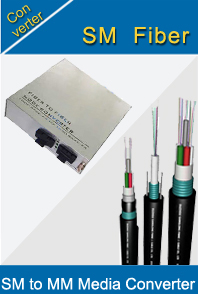
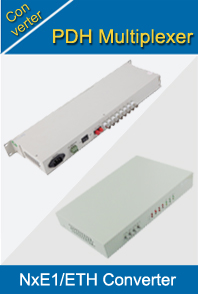
100Gb Ethernet Drivers and Technology
The world is currently experiencing a dramatic escalation in the demands placed upon its global data communications infrastructure. The increase is driven predominately by a shift from text only traffic with modest bandwidth requirements to full multimedia content with bandwidth requirements orders of magnitude more. To accommodate the ever increasing demand for bandwidth, communication links have evolved from copper based channels running in the MB/s range to fiber optic based links running in excess of 10 Gb/s.
In modern data centers for example, 10 Gigabit Ethernet (GBE) ports are commonly used as uplinks for 24- and 48-port 1 GBE switches. The demand for 10 GBE is only expected to increase as switch vendors begin to roll out their next generation platforms with individual port capacities of 10 Gb/s. For these types of systems, it seems logical that any link to an upstream network element requires a throughput much greater than 10 Gb/s. Emerging 100 GBE technologies will provide a path to realizing these high capacity uplinks.
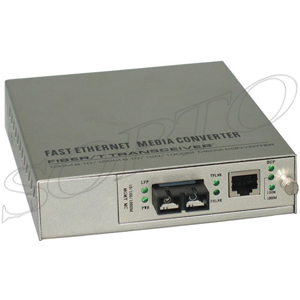
Remote manageable Media Converter
Ethernet is a communications protocol based on a series of IEEE 802.3 standards embedded in software and hardware devices, and is the dominant cabling and low level data delivery technology used in local area networks. First developed in the 1970s, it was published as an open standard by DEC, Intel and Xerox and later described as a formal standard by the IEEE.
Ethernet has become the networking communications technology of choice for so many applications largely because of wide availability of reliable and cost effective products. Strict adherence by the vendors to IEEE 802.3 standards has resulted in a very robust protocol, leading to an ever increasing desire to deploy Ethernet further into the end-to-end network.
Ethernet is also beginning to make inroads into the Storage Area Networking (SAN) space. Benefiting from broader data access, better reliability, lower maintenance costs, and improved disk utilization, networked storage is replacing local hard drives traditionally found in servers. Disk I/O is one of the primary bandwidth consumers in servers, and moving the disks to a remote network drive increases the demand for network I/O bandwidth. Internet SCSI (iSCSI) using Gigabit Ethernet networking is well-proven and capable of supporting the performance, reliability and availability needs for critical applications for mid-tier enterprises.
The emerging Fiber Channel over Ethernet (FCoE) standard will enable the consolidation of both SAN and Ethernet traffic onto one common network adaptor reducing the ever growing number of adaptors required. The goal of FCoE is to create a converged network where servers would use the same interface for the SAN and LAN, and both networks would use one set of cables and switches.
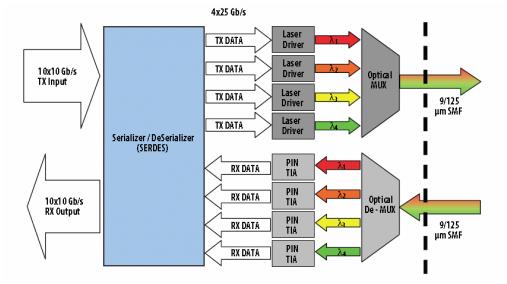
Wavelength Division Multiplexing
In order to address the requirements for the next evolution of Ethernet speed, the IEEE 802.3 Higher Speed Study Group (HSSG) convened to discuss possible solutions. In November 2006, the group concluded that the divergence in bandwidth requirements between the networking and computing industries necessitated a bifurcation in base data rates. To service the next generation of Internet backbone and network aggregation points 100 Gb/s Ethernet seemed like the logical choice, while 40 Gb/s Ethernet appeared better suited to match the bandwidth requirements required by computing technologies such as multi-core processing. For the 100 Gb/s Ethernet standard, the group agreed to support reaches of at least 100 m on OM3 (optical multimode 3, laser optimized) multimode fiber and at least 10 km on single mode fiber. In November 2007, the IEEE 802.3 working group authorized the HSSG to become the IEEE P802.3ba task force whose purpose is to extend the 802.3 protocol to operating speeds of 100 Gb/s and 40 Gb/s while maintaining maximum compatibility with the installed base of 802.3 interfaces. The tentative timeline for this task force calls for delivery of a final set of specifications by 2010. In the meantime, the global demand for bandwidth will be fueled in large part by the following:
- Video sharing, streaming and video on demand
- High Definition video transmission
- Online media content delivery and storage
- Enterprise traffic
- Data exchange between corporate, academic and medical research facilities, and high performance computing installations
For more info, please browse our website or contact a Sopto representative by calling 86-755-36946668, or by sending an email to info@sopto.com.

